How-To Guides
How to Clean Dishwasher Filter: A Complete Step-by-Step Guide
AZparts Team
Updated on July 11, 2025
7 min read
A clean dishwasher filter is crucial for optimal appliance performance and sparkling dishes. Many homeowners neglect this simple maintenance task, leading to poor cleaning, bad odors, and costly repairs. Understanding how to clean dishwasher filters properly extends your appliance's life and improves efficiency. At AZParts, we provide genuine replacement parts and expert guidance to keep your dishwasher running like new.
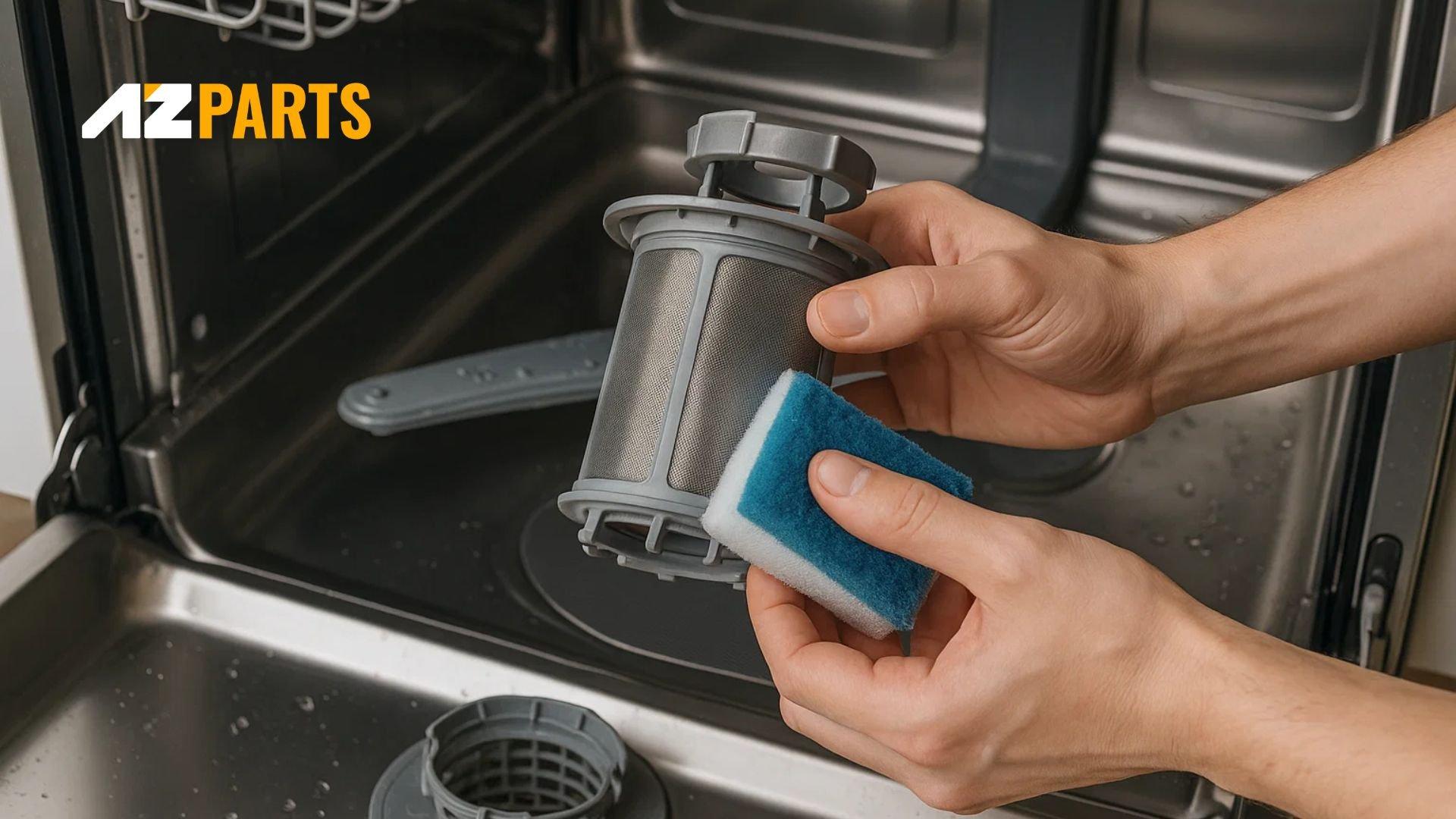
1. Where Is a Dishwasher Filter and Why Clean It?
The dishwasher filter sits at the bottom of your dishwasher tub, beneath the lower spray arm. This cylindrical mesh component catches food particles, grease, and debris before they can clog drains or recirculate onto dishes. Most modern dishwashers feature removable filters requiring regular cleaning.
A dirty filter creates multiple problems. Food particles and soap scum accumulate, breeding bacteria and causing foul odors. Your dishwasher works harder with a clogged filter, increasing energy costs and risking internal damage. Poor filtration results in spots, residue, and food particles on supposedly clean dishes.
Regular cleaning prevents these issues while ensuring efficient operation. Clean filters allow proper water flow, enabling spray arms to distribute water evenly and remove debris effectively. This simple maintenance saves money on energy bills and prevents expensive repairs.
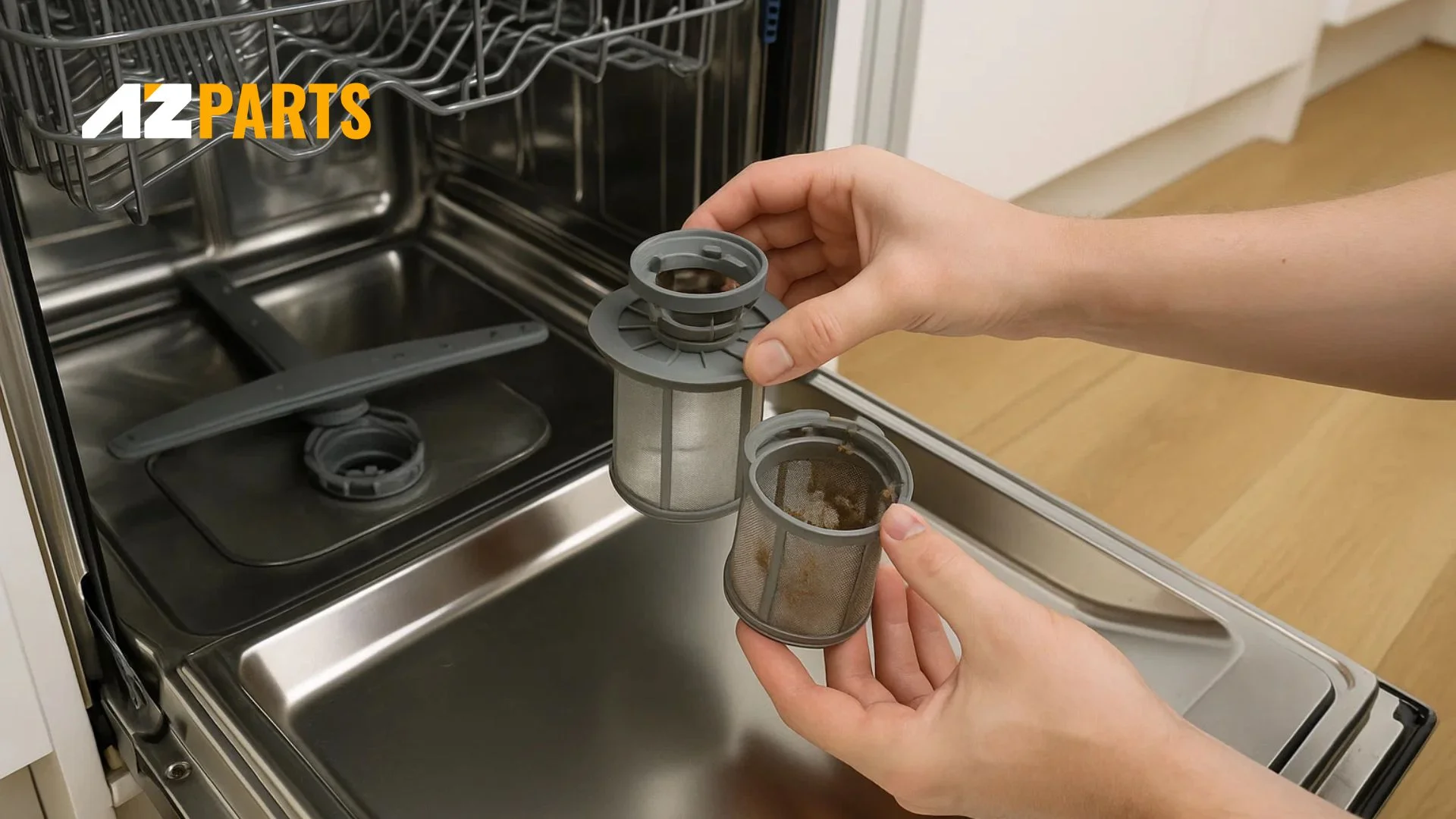
Clean filters allow proper water flow (Source: AZParts)
2. What You'll Need
Gather these supplies before starting:
- Warm water for dissolving grease and particles
- Dish soap or mild detergent for breaking down residue
- Soft-bristled brush (old toothbrush works well)
- Clean towels for drying
- Flashlight for better visibility
- Small bowl for soaking (optional)
Avoid wire brushes or abrasive materials that could damage the filter mesh. Having everything ready ensures efficient, thorough cleaning without interruption.
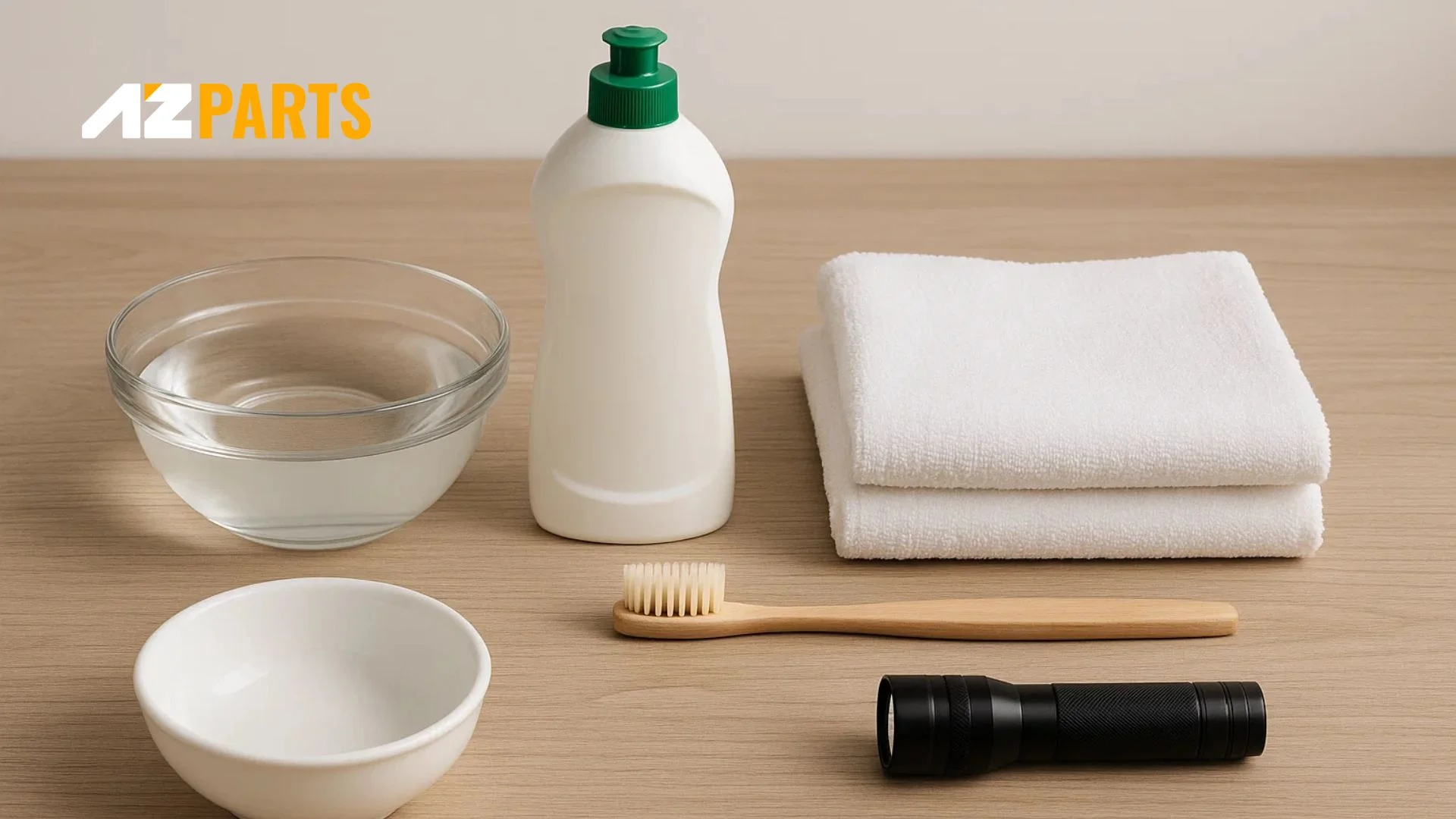
Gather the necessary supplies to ensure a thorough and efficient cleaning process (Source: AZParts)
3. How to Clean a Dishwasher Filter
Step 1: Pull Out the Bottom Rack
First, turn off your dishwasher and ensure it's completely cool for safety. Next, remove the bottom dish rack by pulling it straight out. This step creates the necessary workspace and prevents interference during cleaning. Additionally, check for visible debris or standing water that indicates drainage problems.
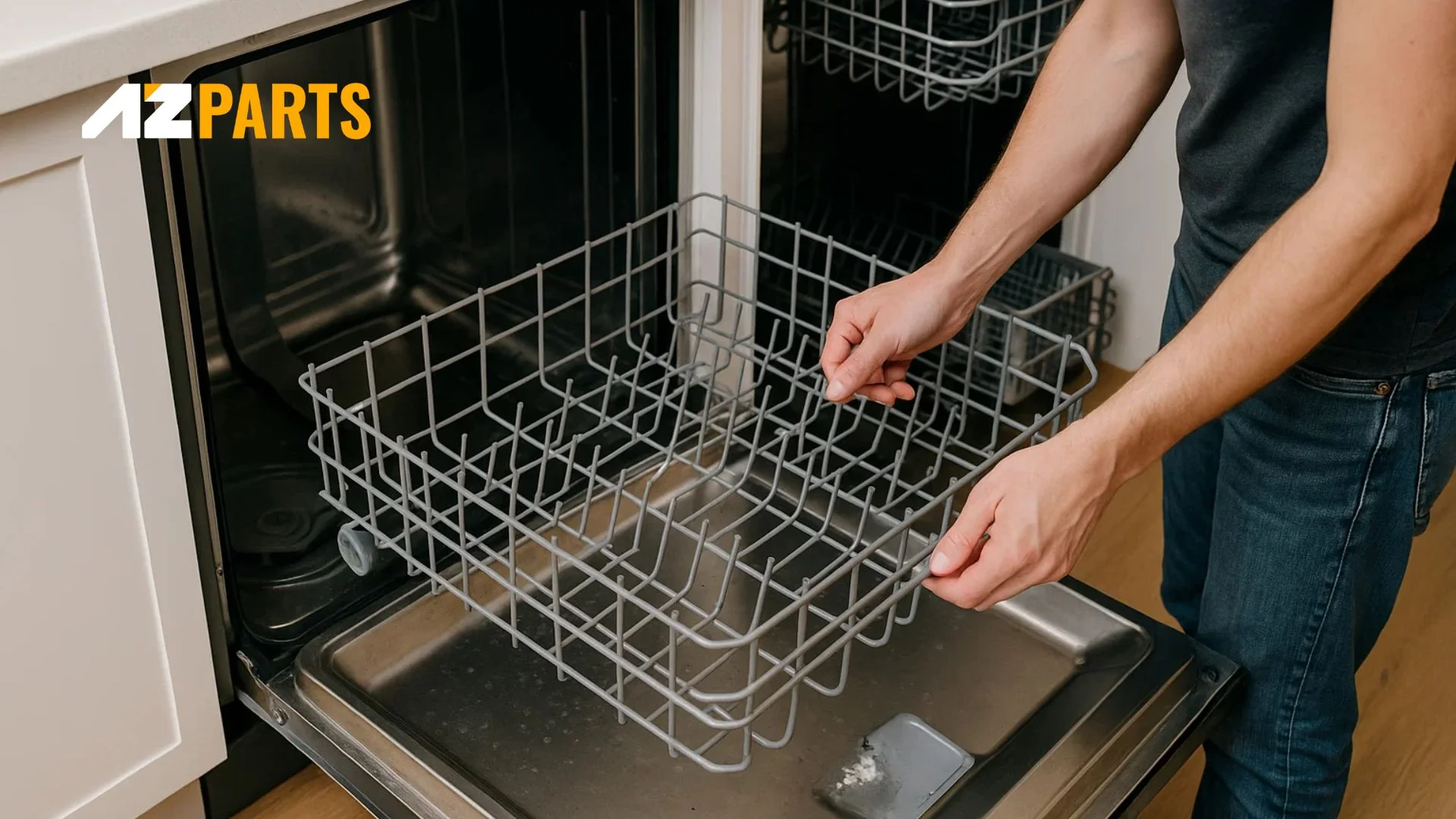
Pull out the bottom rack (Source: AZParts)
Step 2: Locate and Remove the Filter
Now that you have clear access, find the filter at the dishwasher floor center, beneath the lower spray arm. The filter appears cylindrical or circular with a mesh design. If it has a locking mechanism, twist counterclockwise, or simply lift straight up for basic removal types. Before proceeding, note the orientation for easier reinstallation. Furthermore, some models have multiple filter components, so remove all cleanable parts.
Step 3: Soak and Scrub the Filter
Begin by rinsing the filter under warm water to remove loose debris. Then, create a cleaning solution with warm water and dish soap. Allow the filter to soak for 10-15 minutes to soften stubborn buildup. After soaking, use a soft brush to scrub mesh surfaces in circular motions, focusing on areas with visible accumulation. If necessary, repeat the soaking process for particularly stubborn deposits.
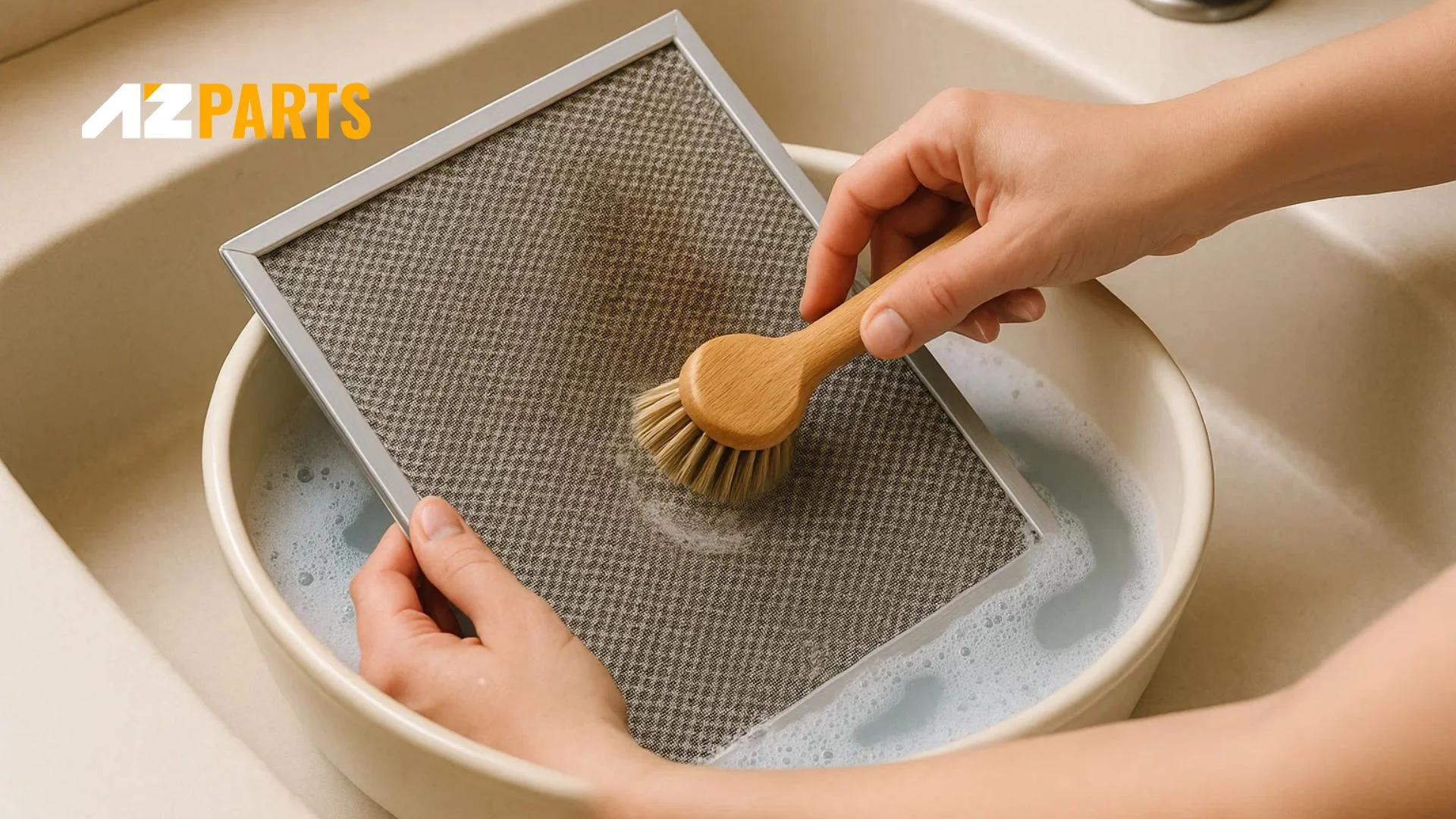
Soak and scrub the filter (Source: AZParts)
Step 4: Rinse the Filter Thoroughly
Following the scrubbing process, rinse the filter thoroughly under warm running water, holding it at different angles to flush all mesh openings. Make sure all soap residue and debris are completely removed. As a result, the mesh should appear completely clean and free of particles. For better results, use spray nozzle settings for additional cleaning power if available.
Step 5: Wipe the Filter Housing Area
While the filter air-dries, take this opportunity to clean the housing area with a damp cloth. Carefully remove debris around the drain opening and filter seat. Also, clean the dishwasher floor and remove any standing water. This important step prevents immediate recontamination when the filter is reinstalled.
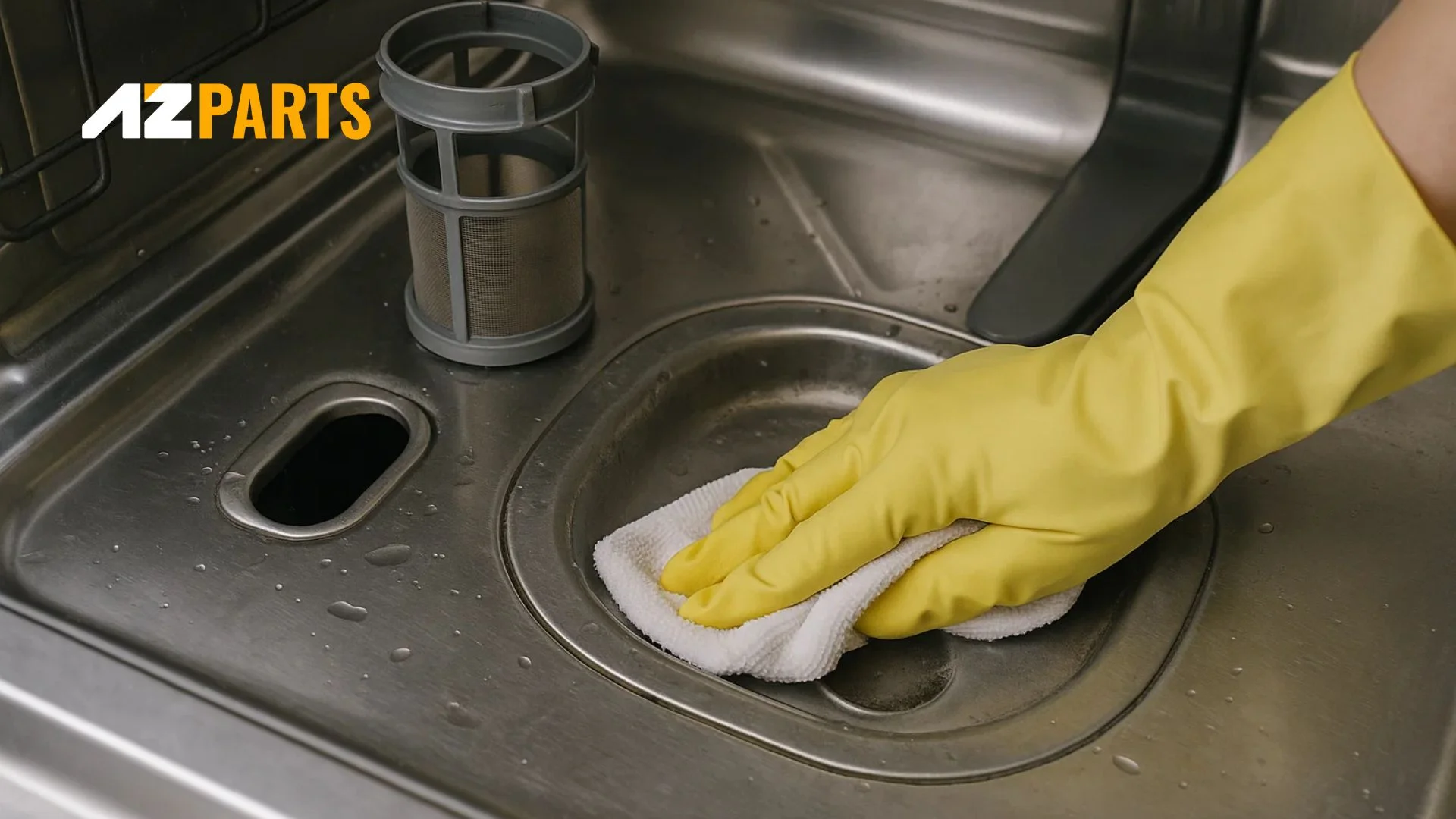
Wipe the Filter Housing Area (Source: AZParts)
Step 6: Reinstall the Filter
Once the filter is completely dry, carefully reinstall it in its original position. Make sure to ensure proper seating and orientation before securing it in place. If your model has a twist-lock mechanism, turn it clockwise until secure. Finally, test the installation by gently trying to lift the filter - it should be firmly in place. Complete the process by replacing the bottom rack and running a short rinse cycle to verify proper operation.
Maintaining your dishwasher filter is essential for optimal performance and longevity. A clean filter ensures proper water circulation and prevents food particles from redepositing on your dishes. If you need to replace your dishwasher filter, you can find high-quality dishwasher filter parts at AZParts, which offers reliable filtration solutions for various dishwasher models.
4. How Often Should You Clean Your Dishwasher Filter?
Clean your filter monthly for average households. Heavy users or those washing heavily soiled items should clean every 2-3 weeks. Clean immediately if you notice poor cleaning performance, bad odors, or food particles on clean dishes.
Hard water areas require more frequent cleaning due to mineral buildup. Households frequently washing items with baked-on food should also increase cleaning frequency to prevent excessive accumulation.
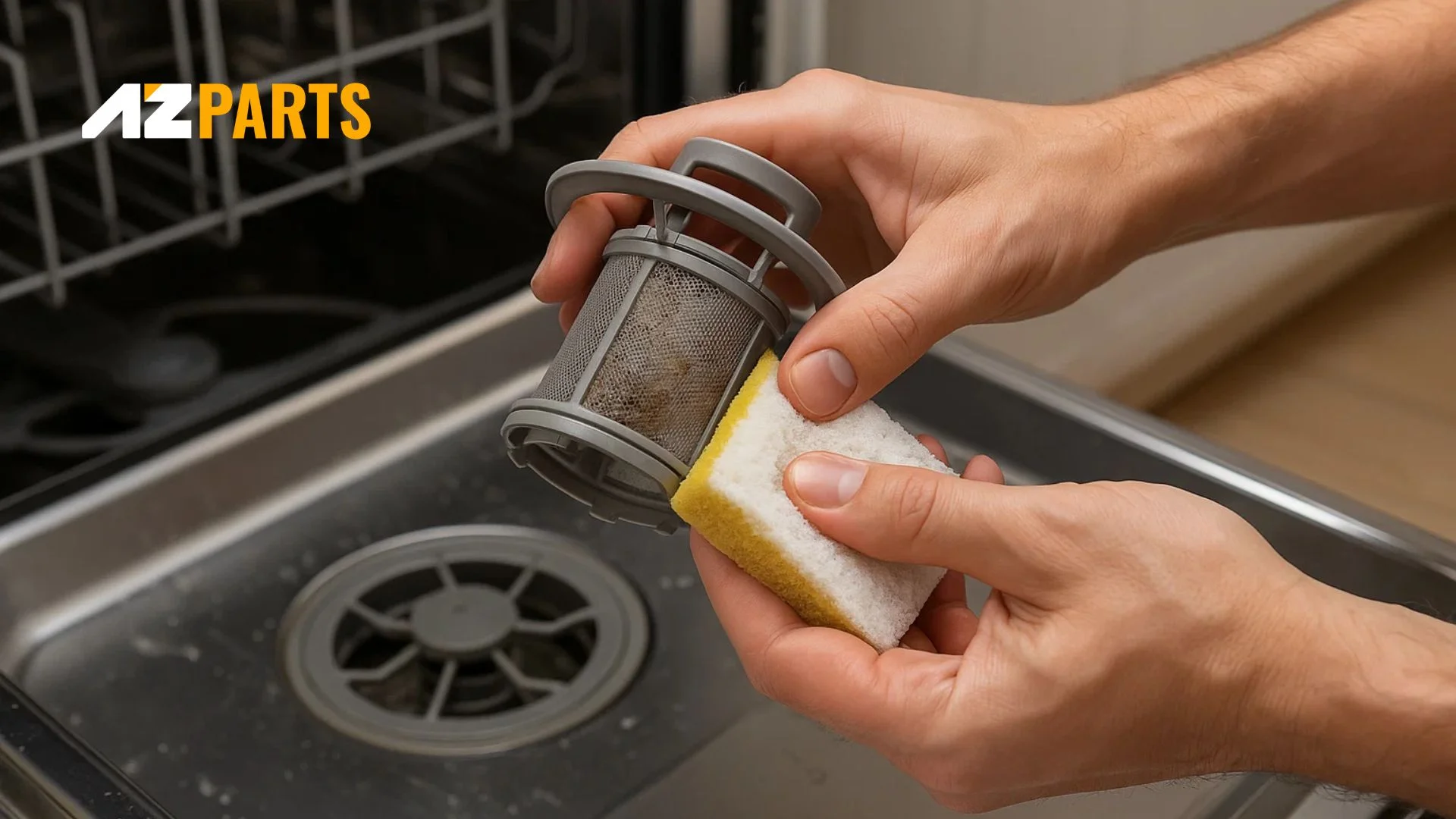
How Often Should You Clean Your Dishwasher Filter? (Source: AZParts)
5. Tips to Keep Your Dishwasher Filter Clean Longer
Follow these simple practices to extend the time between filter cleanings:
Pre-Loading Preparation:
- Scrape food scraps from dishes before loading
- Avoid complete pre-rinsing - modern dishwashers need some residue to work effectively
- Remove large particles but leave light food residue
Use Quality Products:
- Choose high-quality dishwasher detergent for better particle breakdown
- Add rinse aid to improve cleaning performance and reduce residue
- Follow manufacturer's dosage recommendations
Proper Loading Techniques:
- Load dishes correctly to ensure optimal water circulation
- Don't overcrowd the racks - water needs to reach all surfaces
- Face soiled surfaces toward spray arms
Monthly Maintenance:
- Clean spray arms to maintain proper water distribution
- Wipe door seals and gaskets regularly
- Clean interior surfaces to prevent buildup
- Check and clean the dishwasher drain area
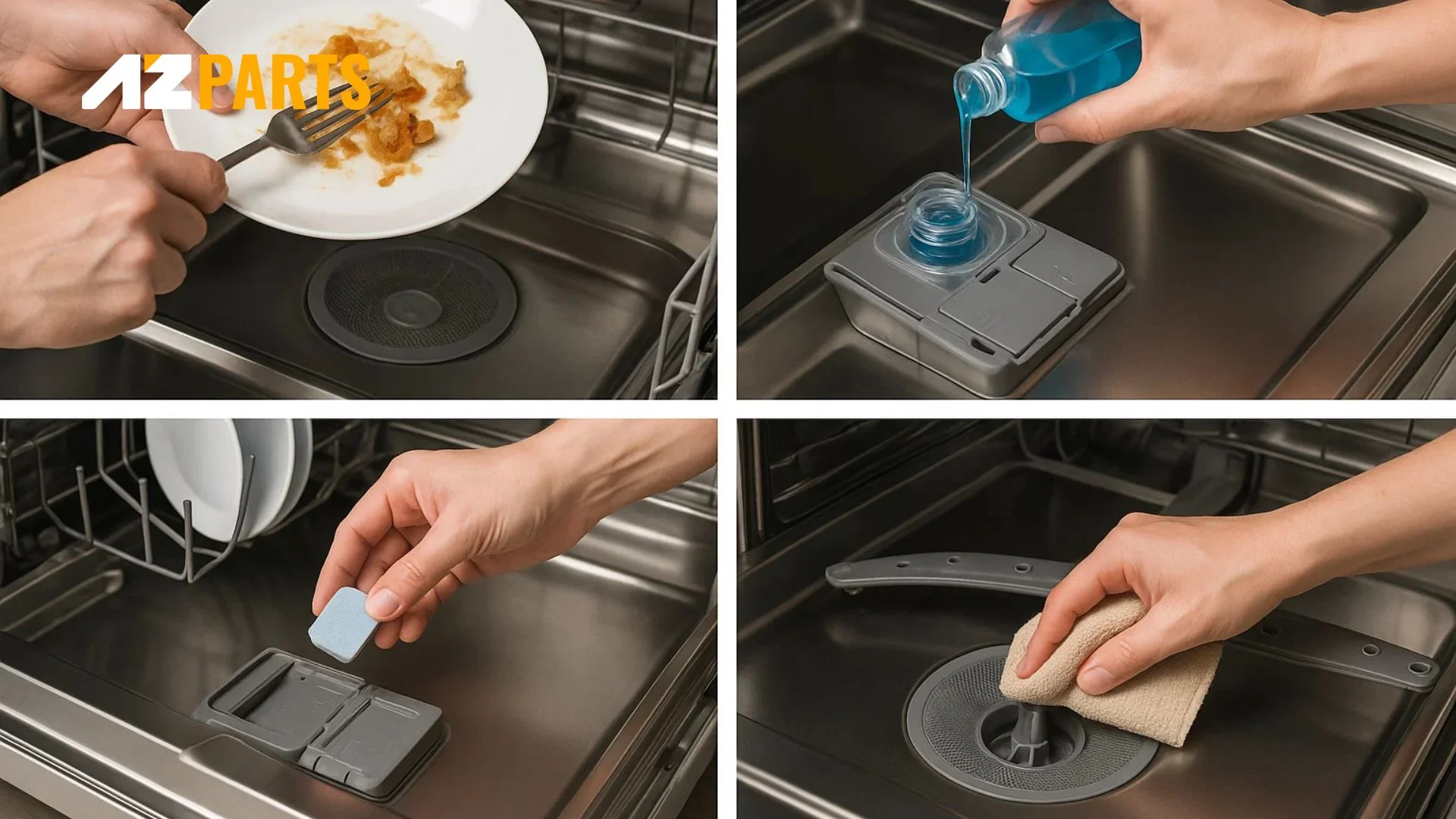
Tips to Keep Your Dishwasher Filter Clean Longer (Source: AZParts)
When all components work efficiently, your filter stays cleaner longer and your dishwasher performs better. If performance issues persist despite regular cleaning, consider replacement parts from AZParts' genuine component selection.
6. Do All Dishwashers Have Filters That Need Cleaning?
Older dishwashers (pre-2010) often have built-in disposals that pulverize particles, requiring no user cleaning. Modern dishwashers use removable filters for environmental benefits, quieter operation, and better energy efficiency.
Check your owner's manual or look for removable components at the dishwasher bottom to determine your model type. Major brands like Bosch, KitchenAid, Whirlpool, and GE typically feature cleanable filters in current models.
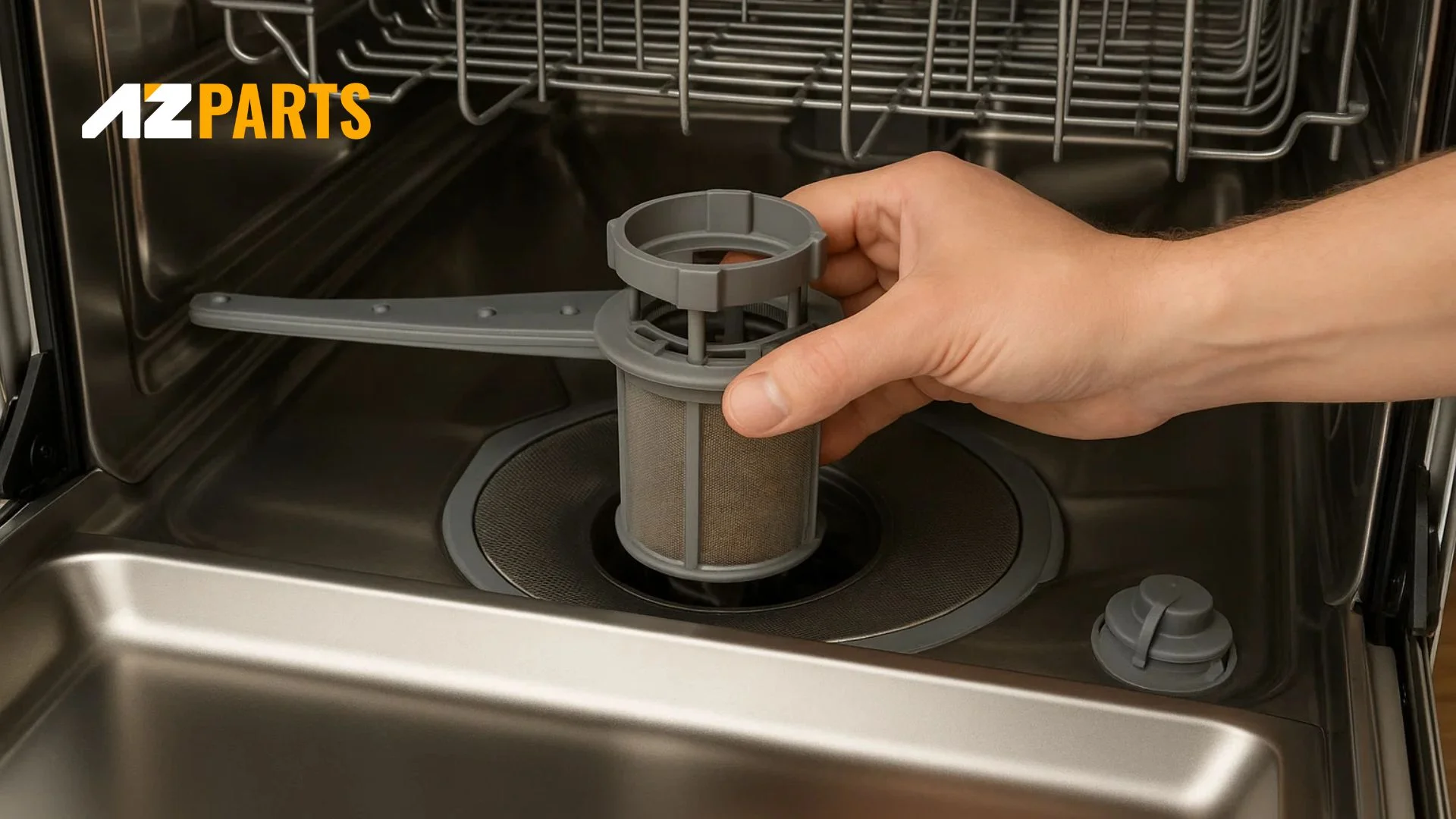
Do All Dishwashers Have Filters That Need Cleaning? (Source: AZParts)
7. Frequently Asked Questions
7.1 Can I use vinegar to clean the dishwasher filter?
Stick with warm water and mild dish soap. Vinegar's acidity can damage filter materials over time. The soap and water method effectively removes debris without risking damage.
7.2 How do I know if my filter is clogged?
Signs include poor cleaning with food particles on dishes, bad odors from the dishwasher, standing water after cycles, or gritty film on dishes despite proper detergent use.
7.3 Is it safe to run the dishwasher with a dirty filter?
No. Dirty filters cause poor cleaning, increased energy consumption, and potential internal damage. A clogged filter forces your dishwasher to work harder, potentially shortening its lifespan.
Regular dishwasher filter cleaning is essential for optimal performance and appliance longevity. This simple monthly task prevents odors, ensures clean dishes, and protects your investment. Follow this guide to establish proper maintenance habits that save money and frustration.
Start your regular cleaning routine today. For genuine replacement parts and expert guidance, trust AZParts to provide quality dishwashers parts for all your appliance maintenance needs.
Contact Information:
8 The Green, Ste A, Dover, Delaware 19901-3618, United States
support@azparts.com
support@azparts.com
Learn how to properly clean your dishwasher’s internal components:
Dishwasher
Further Reading
Further Reading

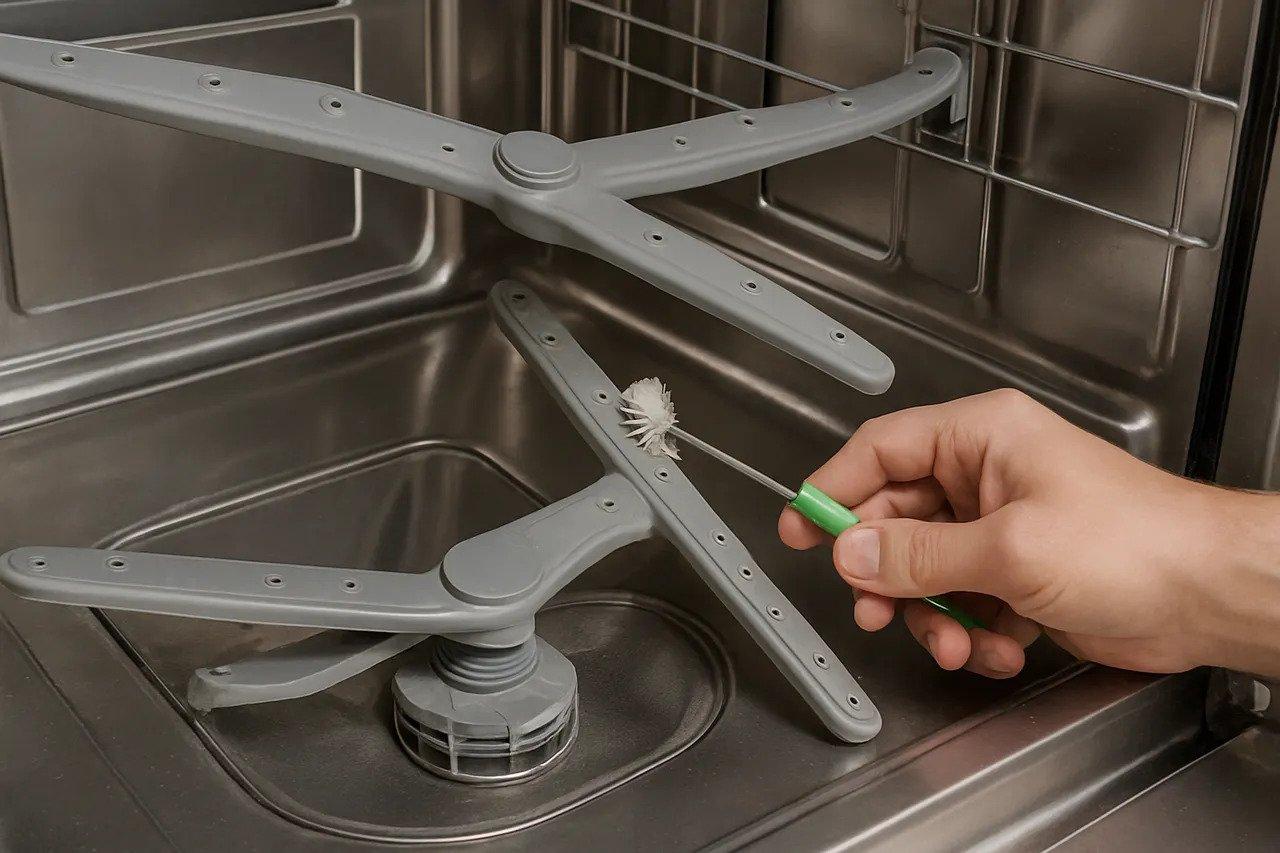

_1748246700.jpg&w=3840&q=75)

